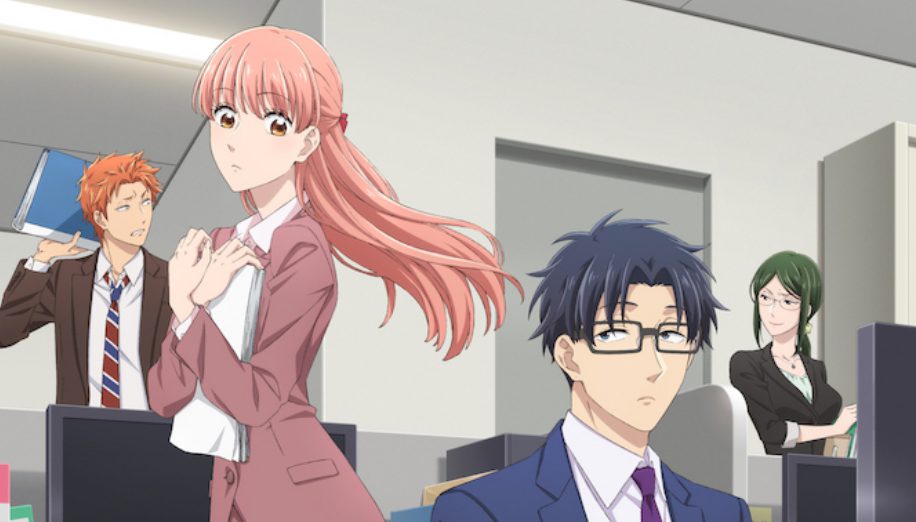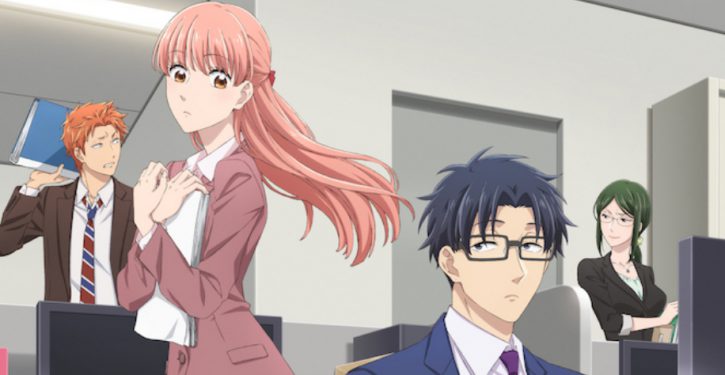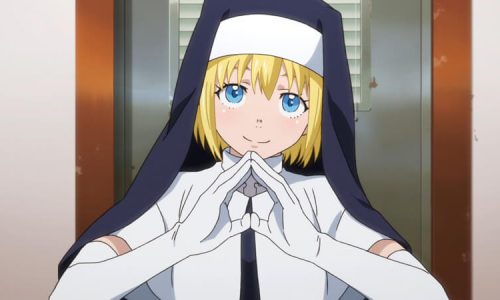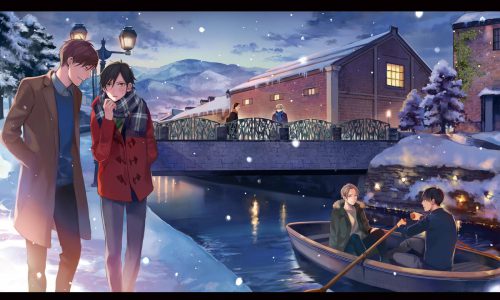From series like Bakuman about mangakas to Shirobako showing insight into the anime industry, the theme of showing some of the workings behind some of our favourite forms of entertainment has been ever increasing. Here, we will introduce two of the more recent ones that got adapted into anime, and some of the terms used in them. Bringing you some of the otaku culture and terminology used in Japan. You may have heard of some if not all of them, but for those who haven’t, we hope to be able to provide this knowledge for even just one new one.
Wotakoi: Love is Hard for Otaku

Wotakoi: Love is Hard for Otaku (Wotakoi) is a comedy work mainly about the funny love stories of otaku couples – Narumi Momose & Hirotaka Nifuji, and Hanako Koyanagi & Taro Kabakura. They are colleagues in the same company who are all secretly otakus. The two females, Narumi and Hanako, are fujoshi who enjoy Boys’ Love (BL) comics, and the males are game otaku who love games.
This anime contains plenty of Japanese otaku terminology so it may be hard to understand if you don’t know Japanese otaku culture very well. Thus, we would like to introduce some of the Japanese otaku culture in this work in detail.
Doujinshi conventions in Japan
In Wotakoi, Narumi and Hanako often participate in doujinshi conventions. Narumi is a manga artist who draws and sells her self-published works, and Hanako is a famous cosplayer who often cosplays as male characters.
Doujinshi (同人誌 dōjinshi)
Doujinshi may seem like they’re all fanwork most of the time, but they actually consist of original works as well. As many people may have known, in Japan, the largest and most famous doujinshi event is the Comic Market (Comiket). But there are actually a whole lot more doujinshi events in Japan. They are divided into “all-genres”, “only genre” and “original work” events. Comiket is the typical “all-genre” doujinshi fair, where you can find creators from almost all fandoms. The “only genre” event usually do not have such a large scale. As its name suggests, it is a doujinshi event featuring work from a specific fandom, like “Hetalia only” etc. And lastly, “original work” events entirely features original works.
Doujinshi conventions are held quite frequently in Japan – it’s not hard to find at least one every month, and is one of the most important channels of doujinshi transactions and fan communication. If you are a big fan of a work, you might want to try to see if there is a doujinshi event with it when planning your stay in Japan. These events usually require a “ticket” for entry but those are typically sold at the entrance too so you don’t have to worry too much about it. The “tickets” are usually the catalog for the event which include the circles’ information of that convention.
“Erohon” in Japan
“Erohon” is the Japanese short for “Erotic book”. It might be obvious from the name, they are books featuring erotic contents.
There is an interesting scene in Wotakoi where Hanako encourages Narumi to find the “Erohon” in the room of her boyfriend, Nifuji. Hanako’s boyfriend, Tabakura, tries to prevent that and says, “Nifuji may hold e-books instead of physical ones”, where Hanako replies with, “Not possible.” But they finally failed to find any in Nifuji’s room.
Why would Hanako think so? Probably because in japan, you could easily buy an erohon in the convenience store. In Tokyo, it means that you can find one anywhere in within range of about 500 meters. Although the internet is very developed today, the Japanese still love paper media. Especially otakus, probably because of doujinshi, which is mostly in physical printed form, so they still maintain a high acceptance of physical media.
Games in Wotakoi
In Wotakoi, the two couples often hold game parties in Nifuji’s apartment. When talking about party games, we may remember Nintendo. Exactly that. Since the original manga that Wotakoi is based off started from April 2014, the Nintendo Switch has not been released so they play with the WiiU. Though the game screen has never been shown in Wotakoi, it has been speculated that they play Mario Cart and Super Smash Bros the most.
It is interesting that in the original manga, Nifuji, as the game otaku, also plays Monster Hunter on the PSP, but it turns into the Nintendo Switch in the anime. There is also one scene where Nifuji says he played one game overnight with a gesture of a squid, which clearly refers to Splatoon.
Comic Girls

Comic Girls is as the title suggests, an anime about girls making comics. It is based off a 4-koma manga of the same name. The story follows a few female high schooler mangakas living together in a dorm specifically for aspiring mangakas. The residents are all at different stages and levels into the manga industry so we get to see a variety of their struggles at each different stage, all the while being cute high school girls doing cute things as well. High schoolers debuting as mangakas isn’t entirely uncommon in Japan so this shows a bit of the problems they face having to balance being both high schoolers and mangakas at the same time.
The protagonist we start the story off with goes by the pen name of Kaos, the uncertain rookie of the bunch. She shows promise but her storyboards keep getting rejected and we see her gain help and inspiration from her dorm mates who are more experienced and all draw different genres of manga. The other main trio are Koyume, a shojo mangaka, Ruki an ecchi mangaka and Tsubasa a.k.a Tsu-chan is a shonen mangaka. This gives us a broader perspective of the different struggles each of them face.
Mangaka (漫画家 mangaka)
As the name suggests, a person who makes manga. From writing the story to drawing it, all while trying to get an ok from the editor in charge and meeting the usually strict deadline. A job not meant for the weak willed.
4-koma manga (4コマ漫画 yonkoma manga)
Literally 4 panel comic. A popular format usually used for comedy. Typically short situations told with just 4 panels. Short, sweet and effective. Most cute girls doing cute stuff type of series are told in this format. Some examples would be as mentioned, Comic Girls, K-On! and New Game!.
Storyboard (ネーム nēmu)
The Japanese for it is literally the English word “name” using the meaning of “to specify”. But the more common and widely used word in English is probably storyboard. Basically the rough layout sketches for how the story would be told in the manga, this goes through the editor first to see if there are anything that needs to be changed. We see Kaos’ struggle with it throughout the series.
Shojo manga (少女漫画 shōjo manga)
Manga targeting young female audiences. Typically features romance and focuses on the emotional aspect of storytelling. Examples of popular shojo series are Sailor Moon, Cardcaptor Sakura and Hana Yori Dango. There is no set rule for art style and setting of the story but it’s common for the style to have large expressive eyes, possibly for ease of expression the emotions.
Shonen manga (少年漫画 shōnen manga)
Manga aimed at young male targets. Some of the most popular long running series are from this genre, like Dragon Ball, One Piece and Gintama to name a few. Usually features action and comedy of the less elegant sort with a focus on the power of friendship. Frequently hot-blooded and gets your blood pumping.
Ecchi manga (エッチ漫画 ecchi manga)
Not straight out porn but features erotic scenes, target audience is clearly older than the above two. Other genres and settings is widely varied, goes from very romantic with a good message to silly hormonal guy and his misadventures. Could be anything that involves some form of sensual element really.
To close it all off, we hope that we’ve managed to provide some insight into the otaku culture within Japan and that this has further piqued your interest on the subject.



